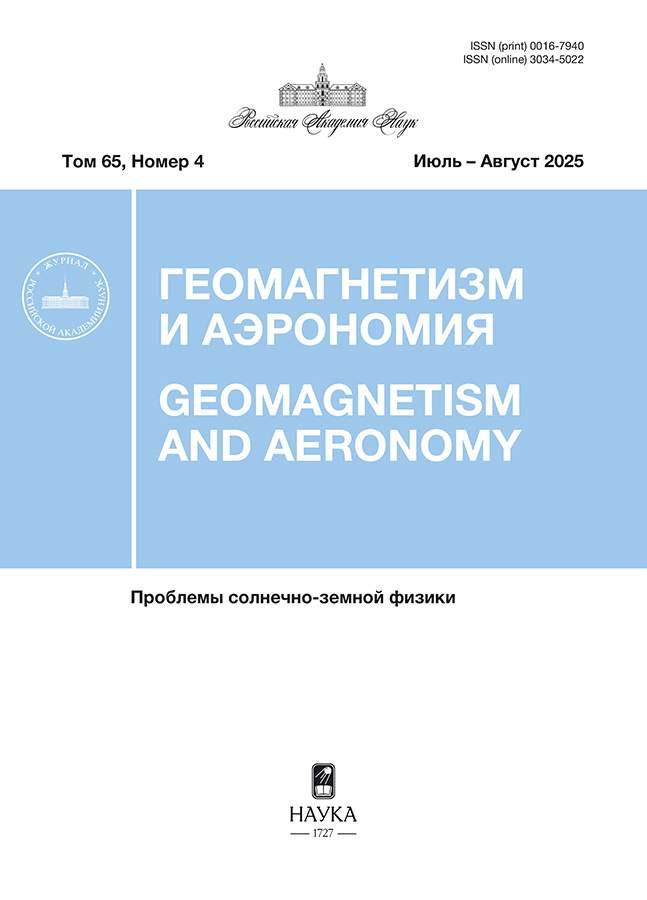Changes over time in the relationship between solar activity indices
- Authors: Deminov M.G.1, Deminova G.F.1
-
Affiliations:
- Pushkov Institute of Terrestrial Magnetism, Ionosphere and Radio Wave Propagation of the Russian Academy of Sciences (IZMIRAN)
- Issue: Vol 65, No 4 (2025)
- Pages: 459-466
- Section: Articles
- URL: https://ter-arkhiv.ru/0016-7940/article/view/688294
- DOI: https://doi.org/10.31857/S0016794025040055
- EDN: https://elibrary.ru/EXQJGB
- ID: 688294
Cite item
Abstract
The results of the analysis of long-term changes in the relationship between solar activity indices for 1957–2022 are presented. For this purpose, the smoothed (using a 24-month filter) indices F10, F30, Ly-α, MgII, Ri and IG were used: the solar radio emission flux at the wavelengths of 10.7 and 30 cm, solar radiation in the Lyman-alpha line of hydrogen (121.567 nm), the ratio of the central part to the flanks in the magnesium emission band of 276–284 nm on the Sun, the international sunspot number and the ionospheric index, which is determined from ionospheric data as an analogue of the sunspot number. It was confirmed that the entire measurement period can be divided into the intervals 1957–1980, 1981–2012 and 2013–2022, in which the relationships between the solar activity indices are clearly different. In the interval 1957–1980, these relationships are stable over time, i.e. there is practically no linear time trend in the dependence of one solar activity index on another. In the 2013–2022 interval, such trends are usually significant. In this interval, the trend ∆IG(X) = IG – IG(X) is negative and significant for X = F10, F30, MgII, Ly-α, or Ri, where IG(X) is the average dependence of IG on X for this interval.
Keywords
Full Text
About the authors
M. G. Deminov
Pushkov Institute of Terrestrial Magnetism, Ionosphere and Radio Wave Propagation of the Russian Academy of Sciences (IZMIRAN)
Author for correspondence.
Email: deminov@izmiran.ru
Russian Federation, Moscow, Troitsk
G. F. Deminova
Pushkov Institute of Terrestrial Magnetism, Ionosphere and Radio Wave Propagation of the Russian Academy of Sciences (IZMIRAN)
Email: deminov@izmiran.ru
Russian Federation, Moscow, Troitsk
References
- Деминов М.Г. Связи между индексами солнечной активности в разные интервалы времени // Геомагнетизм и аэрономия. Т. 65. № 2. 2025.
- Danilov A.D., Berbeneva N.A. Statistical analysis of the critical frequency foF2 dependence on various solar activity indices // Adv. Space Res. V. 72. № 6. P. 2351–2361. 2023. https://doi.org/10.1016/j.asr.2023.05.012
- Danilov A.D., Konstantinova A.V. Trends in foF2 to 2022 and various solar activity indices // Adv. Space Res. V. 71. № 11. P. 4594–4603. 2023. https://doi.org/10.1016/j.asr.2023.01.028
- Hathaway D.H., Wilson R.M., Reichmann E.J. A synthesis of solar cycle prediction techniques // J. Geophys. Res. – Space. V. 104. № 10. P. 22375–22388. 1999. https://doi.org/10.1029/1999JA900313
- Hathaway D.H. The solar cycle // Living Rev. Sol. Phys. V. 12. ID 4. 2015. https://doi.org/10.1007/lrsp-2015-4
- Jones W.B., Gallet R.M. The representation of diurnal and geographic variations of ionospheric data by numerical methods // Telecommun. J. V. 29. № 5. P. 129–149. 1962.
- Jones W.B., Gallet R.M. The representation of diurnal and geographic variations of ionospheric data by numerical methods. 2 // Telecommun. J. V. 32. № 1. P. 18–28. 1965.
- Laštovička J., Burešova D. Relationships between foF2 and various solar activity proxies // Space Weather. V. 21. № 4. ID e2022SW003359. 2023. https://doi.org/10.1029/2022SW003359
- Laštovička J. Dependence of long-term trends in foF2 at middle latitudes on different solar activity proxies // Adv. Space Res. V. 73. № 1. P. 685–689. 2024. https://doi.org/10.1016/j.asr.2023.09.047
- Liu R., Smith P., King J. A new solar index which leads to improved foF2 predictions using the CCIR atlas // Telecommun. J. V. 50. № 8. P. 408–414. 1983.
- Machol J., Snow M., Woodraska D., Woods T., Viereck R., Coddington O. An improved Lyman-alpha composite // Earth and Space Science. V. 6. № 12. P. 2263–2272. 2019. https://doi.org/10.1029/2019EA000648
- Mursula K., Pevtsov A.A., Asikainen T., Tahtinen I., Yeates A.R. Transition to a weaker Sun: Changes in the solar atmosphere during the decay of the Modern Maximum // Astron. Astrophys. V. 685. ID A170. 2024. https://doi.org/10.1051/0004-6361/202449231
- Snow M., Machol J., Viereck R., Woods T., Weber M., Woodraska D., Elliott J. A revised Magnesium II core-to-wing ratio from SORCE SOLSTICE // Earth and Space Science. V. 6. № 11. P. 2106–2114. 2019. https:// doi.org/10.1029/2019EA000652
- Upton L.A., Hathaway D.H. Solar cycle precursors and the outlook for cycle 25 // J. Geophys. Res. – Space. V. 128. № 10. ID e2023JA031681. 2023. https://doi.org/10.1029/2023JA031681
Supplementary files














